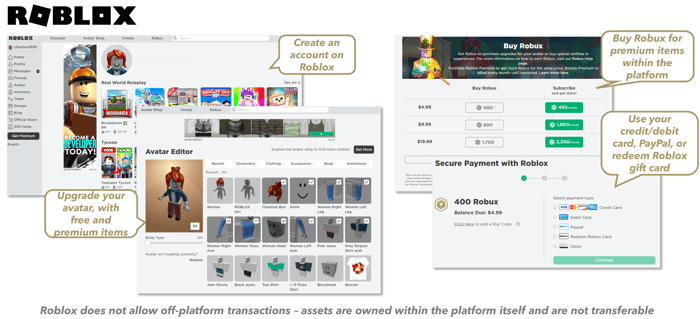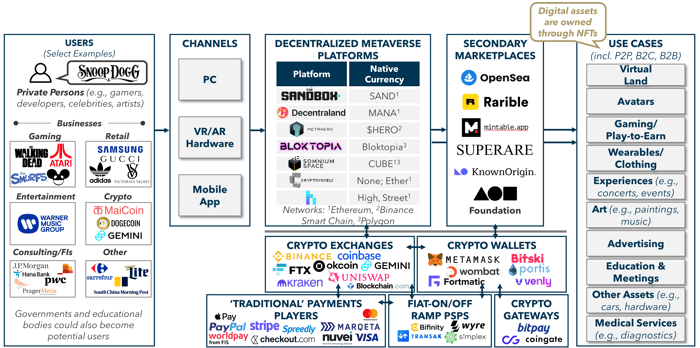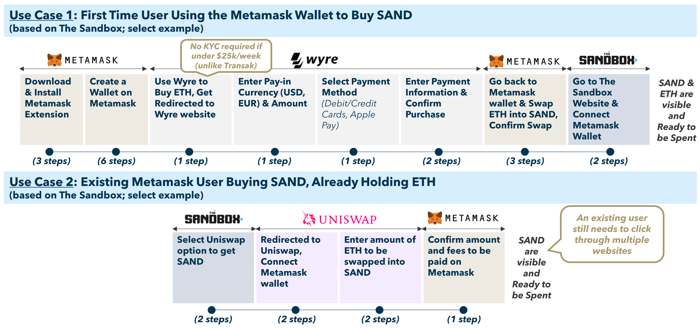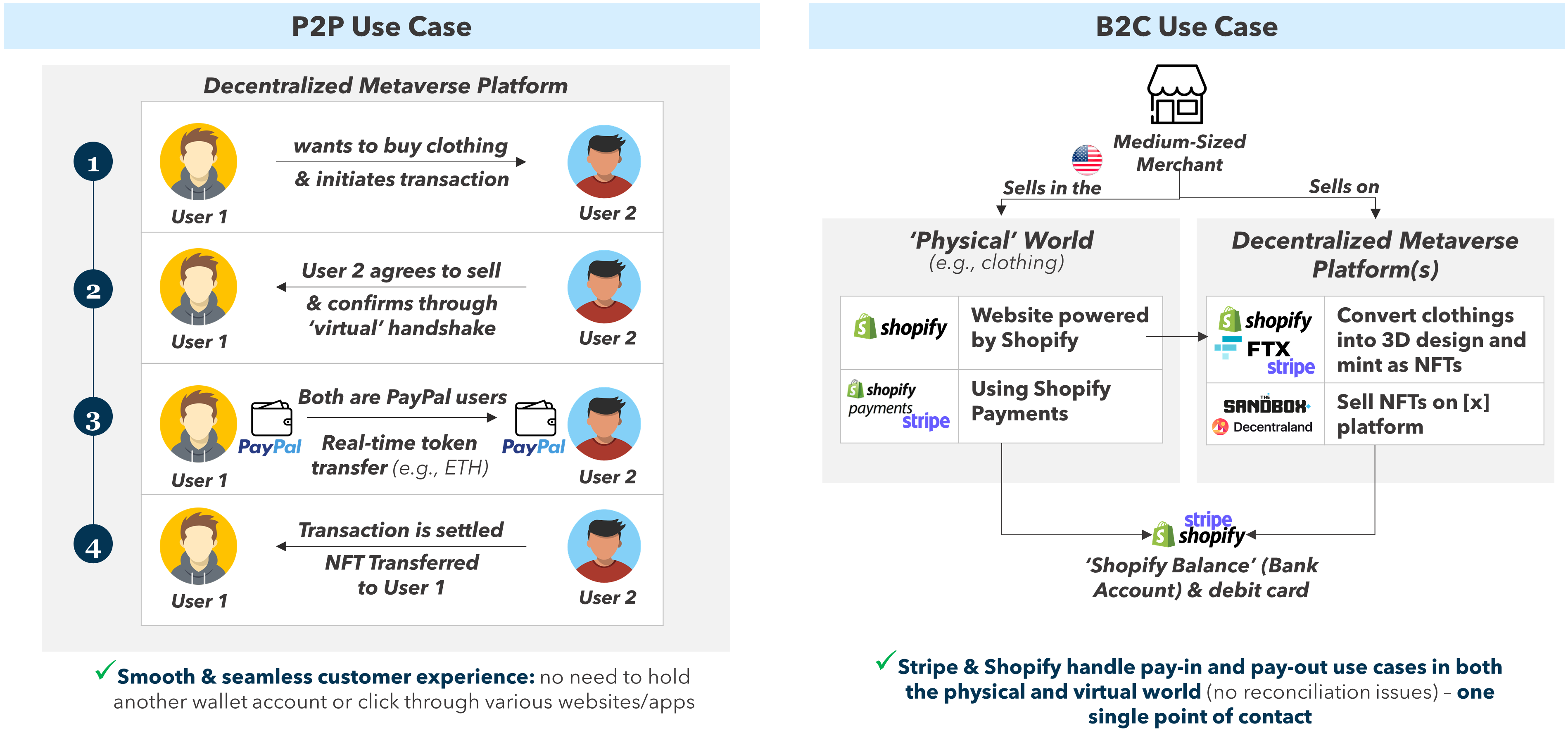Payments use cases and services adapt to life and our changing commerce experiences. In the late 90’s and early 2000’s, payments evolved to meet the needs of e-commerce. In the 2010’s, payments evolved for mobile commerce. The next horizon of payments evolution is the Metaverse. In this article, we discuss the reality of nascent payments in the Metaverse today and our expectations for evolution towards a more frictionless user experience.
What is the Metaverse?
The Metaverse refers to an online, virtual, 3D universe that users can access via PC, virtual reality (VR) / augmented reality (AR) hardware, and/or mobile application, where the virtual and physical world converge. Users can play, work, transact, meet, and socialize within a virtual community. Video gaming worlds (e.g., World of Warcraft, Fortnite) or video game platforms (e.g., Roblox) are the closest analogies to the Metaverse. However, there are fundamental differences between video gaming worlds which are fundamentally proprietary and the vision of the Metaverse which is intended to be interconnected and open.
Both video gaming worlds and the Metaverse are built for virtual goods and commerce. Virtual goods in video gaming are rarely useable across platforms, however, the Metaverse assets are built to be shareable. The vision of the Metaverse is open and community governed, where users are the ultimate owners and contributors based on community, openness, and distributed ownership of virtual assets, The Metaverse is built on blockchain where virtual assets are owned through non-fungible tokens (NFTs) and transferrable across platforms. Video gaming payments are generally achieved via more mainstream rails (cards, wallets), while payments in the Metaverse are (today) driven by crypto and blockchain.
Roblox illustrates the closed nature of today’s video gaming worlds. As shown in Figure 1, Roblox, a leading online gaming platform, allows players to purchase upgrades for avatars (e.g., clothing, accessories) or buy experiences on its website. It has its own in-game currency (Robux) which users can purchase on their website using traditional payment rails (credit/debit cards, PayPal, gift cards). Roblox issued a statement on its blog in November 2021, re-emphasizing that it does not allow off-platform auctions: “When off-platform transactions occur that are tied to on-platform items or experiences, it is impossible for us to monitor the details of that event and it blocks our ability to validate or mediate any claims.”
FIGURE 1:Illustrative Transaction Process on Roblox, a Leading Online Video Gaming Platform (screenshots)

The Metaverse is still in its infancy as most platforms are alpha or beta versions and not yet fully formed. There is no single virtual ‘world’ in the Metaverse, but a combination of many different worlds. Today, the two largest virtual worlds are The Sandbox (500k+ registered wallets) and Decentraland (c.300k monthly active users). Both worlds are built on the Ethereum blockchain. The Sandbox was founded in 2011 and owned by Hong-Kong-headquartered game software company Animoca Brands. Despite this, the company has made it clear that the virtual world is 100% owned by the players and fully decentralized, leveraging the blockchain technology and NFTs.
“The Sandbox is a virtual world where players can build, own, and monetize their gaming experiences in the Ethereum blockchain. […] The goal: disrupt existing game makers like Minecraft and Roblox by providing creators with true ownership of their creations as non-fungible tokens (NFTs) and reward them for their participation in the ecosystem.”
Unlimited commerce use cases
The Metaverse is envisioned as an alternative reality where virtually anything is possible. The possibilities for commerce use cases are therefore vast. The most common use cases today include buying virtual land, avatars, and play-to-earn games. Emerging use cases include wearables/clothing, experiences, business meetings, education, and much more. The meta-economy will also cover all forms of commerce transactions:
- P2P: Users can trade land or other types of assets among them
- B2C: Retailers can showcase their latest clothing collection, users can buy the clothing in the virtual world, and get it delivered at home
- B2B: Manufacturers can showcase newly developed equipment, build a mirroring version of their ‘real-life’ factory, and hold business meetings across multiple parties
FIGURE 2: The Decentralized Metaverse Ecosystem (select examples)

Source: Flagship Advisory Partners
Blockchain, cryptocurrency, and NFT act as key commerce enablers today
Cryptocurrencies (wallets and exchanges), blockchain technologies, and NFTs play the central role in enabling the Metaverse commerce today. There is no obligation to set up a Metaverse world on the blockchain, but today the largest platforms are leveraging blockchain technologies as it provides a decentralized and transparent way of transacting. Because the Metaverse is built on blockchain, transacting is almost always via cryptocurrencies. As illustrated in Figure 2, most platforms have created their own utility token (e.g., SAND used in The Sandbox, MANA used in Decentraland) which can be bought or swapped on most crypto exchanges.
Metaverse users must set up a crypto-based wallet to hold digital custody and enable crypto payments. For example, Metamask, one of the largest crypto wallets, allows players to send and receive Ethereum-based currencies and tokens, store and manage account keys, and connect to decentralized platforms (e.g., The Sandbox).
Payments user experiences in the Metaverse are clunky today
The Metaverse payment experience of today is clunky, with many steps required to complete a transaction. We analyzed several commerce and payment use cases within The Sandbox and illustrated select results in Figure 3. It takes approx. 19 steps across 3 different websites/apps to buy SAND for a first-time user. This process could involve more steps using a different provider such as Transak, as Wyre offers a KYC exemption for amounts under $25k per week. Similarly, existing users willing to swap ETH into SAND still need to complete approx. 7 steps across 3 websites/apps before holding SAND.
FIGURE 3: Today’s Pay-in Use Cases in the Metaverse (examples based on The Sandbox)
 Source: Flagship Advisory Partners
Source: Flagship Advisory Partners
As shown in Figure 4, users then have multiple options to withdraw their funds, with most common use cases including bank account transfers or a card which is linked to the user’s crypto wallet. Again, the process of transferring the funds to the user’s bank account is painful; on average 21 steps across two apps/wallets. A more user-friendly experience is the second use case shown below, where the user can spend or withdraw funds at an ATM using the Coinbase Visa-branded debit card, directly linked to the user’s Coinbase wallet. However, this involves approx. 15 steps.
FIGURE 4: Today’s Pay-out Use Cases in the Metaverse (examples based on The Sandbox)

Source: Flagship Advisory Partners
Enhanced user experience will define winners in Metaverse payments
Blockchain tech and cryptocurrencies are well built for virtual and decentralized ownership, but not yet well-enabled for frictionless commerce. We expect rapid evolution of crypto commerce payments in the next several years, and these improved experiences will also help to drive UX improvement in the Metaverse. Payments providers that crack the code on frictionless experiences across the Metaverse have massive long-term upside.
Traditional payments providers (card networks, mainstream wallets, PSPs, etc.) play little role in today’s Metaverse commerce and payments. There is rapid convergence of mainstream digital payments and cryptocurrency payments (e.g., FTX’s partnership with Nuvei and Stripe, Binance launching Bifinity), but this is not yet visible in the Metaverse. We expect this to change in the next two years when mainstream wallets, neobanks, and PSPs increase investment into establishing use cases and propositions in the Metaverse. In the long run, the Metaverse will become an alternative channel for customer acquisition and servicing for general financial services providers, including traditional banks.
Traditional wallets and digital commerce platforms have the potential for a strong right-to-win in the Metaverse as enablers of more frictionless commerce. Comparing the number of registered users across select wallets, PayPal has 36x more users than Metamask today. In Figure 5 below, we present two theoretical P2P and B2C use cases leveraging mainstream wallets and payment services rails. Scenario 1 depicts if platform users could transact through a simple virtual handshake using their existing PayPal wallets, without the need to create an additional blockchain wallet (e.g., Metamask), nor the need to click through various apps/websites. Alternatively, scenario 2 depicts if merchants could sell assets in both the physical and virtual world through the same partner, using the same PSP.
FIGURE 5: Tomorrow’s Potential P2P and B2C Payments Use Case in the Metaverse (theoretical illustrations)

Source: Flagship Advisory Partners
The Metaverse is infant but foreshadows the generational future of commerce
The Metaverse is in a state of infancy today and with far more vision than reality. But the long-term impact of the Metaverse for todays’ younger generation is limitless. The Metaverse commerce will be vast as a broad array of use cases shift into the virtual worlds of the Metaverse. Commerce and payments within the Metaverse are not an extension of e-commerce or m-commerce; the Metaverse is the first commerce environment built natively for blockchain and cryptocurrency. Unfortunately, these foundations cause commerce and payment use cases today to be full of friction.
We expect these use cases to become more frictionless based on the broader convergence of cryptocurrency ecosystems and mainstream payments. But while we fully expect mainstream commerce and payments providers to embrace the Metaverse, we do not expect disruption of today’s foundational role for cryptocurrencies-and-blockchain-based payments infrastructure. Even as the Metaverse commerce scales into the billions and beyond, we believe blockchain-based payments and providers will rule the day.
Please do not hesitate to contact Charlotte Al Usta Charlotte@FlagshipAP.com with comments or questions.


